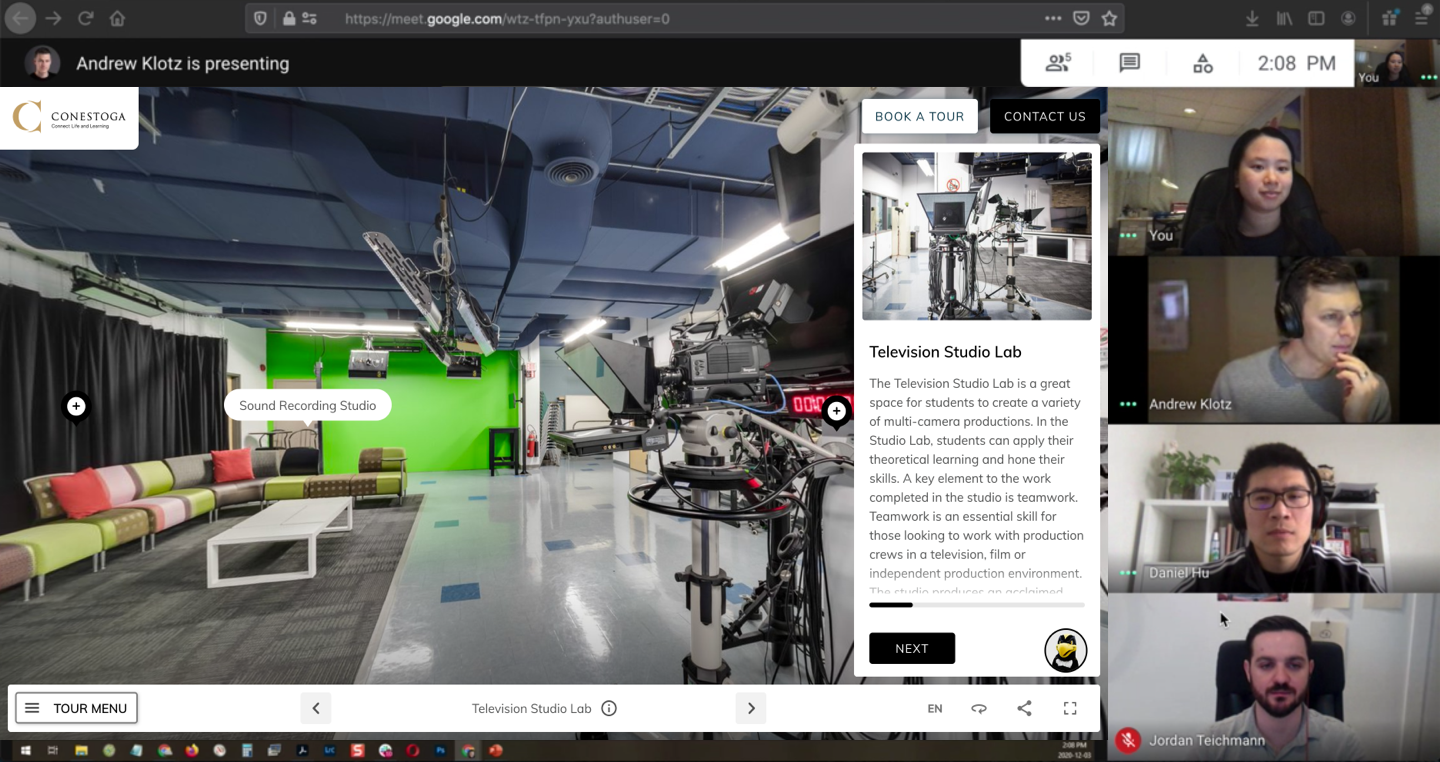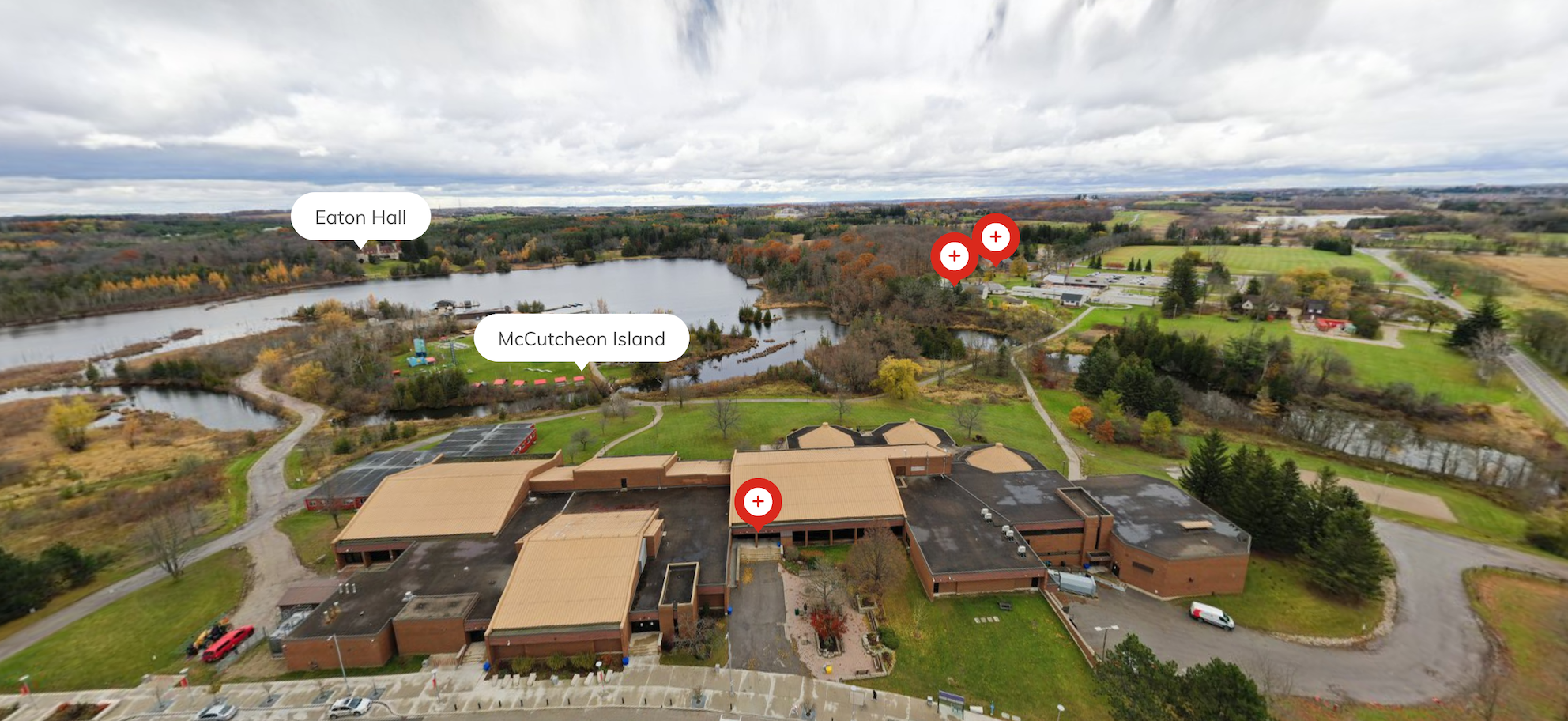
Over the last year, recruitment teams have had to reimagine campus walking tours due to social restrictions. Today, recruiters are delivering guided virtual tours to future students via video conferencing tools like Zoom, Webex, Teams, and others. The overall goals of the virtual format are very much aligned with it's in-person predecessor: impress the benefits of a particular campus on prospective students, and answer questions that ensure they are making the right choice of PSE. Having an experienced tour guide virtually walk attendees through campus makes it more exciting and authentic, even if they have previously explored a virtual tour already. After speaking to a number of customers using this tactic, we’ve summarized their insights to help those interested in putting it into action.
Preparing to run virtual guided tour events
Things You’ll Need

Video Conferencing Tools
There are many popular applications to choose from such as Google Meet, Microsoft Teams, or Zoom. Often, recruiters are using more than one video conference app depending on the audience served. For example, if school boards are using Meet, recruiters should be prepared to use it as well. For the events you host and run, picking a single application will make the workflow easier for your team.
“Our recruitment teams are running daily guided virtual tours through Microsoft Teams and Zoom, to showcase Canadore's biggest assets - our amazing labs, services and faculty.”
- Jesse Russell, Coordinator, Recruitment and Liaison at Canadore College.
Virtual Tour Setup
Schools we spoke to reported that their guided virtual tours sessions are about an hour long, with the tour portion running from 30-45 minutes, and the remainder of the time reserved for Q&A. Within that time, you can reasonably expect to go through 20-25 “stops” on the tour (which we often refer to as scenes). The most logical place to start is to select stops from your in-person campus walking tour. Since your virtual tour affords the ability to add in more content, you can use hotspots to point out key highlights along the way to help tour guides as they narrate the journey for attendees.
Tip: If you’re using Circuit for your virtual tour, you can create Hidden Tours that are not discoverable by the general public exploring your main virtual tour site. Setting up tours accessed and used solely by your tour guides ensures separation for analytics purposes, and doesn't clutter up your main virtual tour experience.
Promoting guided virtual tour events
Once your virtual tour is set up for your guided event, the next step is to promote this resource to future students. The top 3 promotion strategies are:
- Featuring a registration form or link on your campus tours, future students, upcoming events, and virtual tour webpages
- Emailing existing prospects with the opportunity to take a guided virtual tour
- Display ads linking to your recruitment page, with a prominent registration form
On the registration form, you should ask prospects for the following information:
- Who they are - name, age, date of birth, high school, email etc…
- Where are they at on their PSE application journey - are they just looking for information or have they already applied?
- What programs or services they might be interested in
- Pick a guided virtual tour session time most convenient for them
- Opt-in to email communications, which will let you deliver follow-up info through email
In-session: helpful tips on running effective events
When attendees have joined, tour guides typically introduce themselves by sharing their role, and the programs they studied or are enrolled in. Guides often mention if they are local in case students have questions about the surrounding campus area. Encouraging tour guides to share personal anecdotes about each place makes the experience more authentic and less formal. Tour guides can also tailor the guided virtual tours for prospective students by emphasizing scenes that match their interests indicated at registration. A recruitment specialist we spoke to asks attendees their interests during the session, “so that if someone new joins or people have changed their mind since they registered, then we know how we can personalize it for them”.
Should you allow for audience participation?
If the group size is 1-3 try to encourage them to speak up if they have a question but if the group size is large (8-20) ask them to stay muted and have them ask questions in the chat. Lauren Mundt, Campus Tour Guide at Carleton University, encourages larger groups to “hop into the chat and type their questions to a moderator” who helps screen questions for the presenter or “if students have bigger questions they want to have an open discussion about, they can save those for the end”.
How do you position the campus walking tour in a way that sets expectations around returning to campus?
You can definitely address the current pandemic situation near the start of the tour. Let participants know if your campus is open or closed, if footage was taken before or after COVID-19, and if there are any services currently available on-campus for them. Try not to dwell on the topic, we are all hopeful that we will be able to return to campus soon and can still make it an exciting time for prospective students to look forward to.
Should I play a video during this session?
From speaking to recruitment teams, we haven’t seen a huge uptake of sessions that incorporate video plays. Although underutilized, Lauren noted that video is a good way to add in content that is currently not captured in the experience as a panorama to “show some buildings more in depth” and to “give students a good idea of what to expect.”
Ways to drive engagement
A common problem we heard from recruitment teams is that it can be tough to present to empty screens. Students don’t tend to turn on their cameras and rarely unmute to talk, instead opting to type in chat. Don’t be discouraged if this is the reaction. Jesse commented that “virtual will always be tough as it cannot replace our fantastic in-person walking tour experience. The major thing it lacks is interactivity. We're trying to overcome this today by including faculty and current students to share their expertise and experience.”
Here are four potential strategies for generating audience engagement.
1) Add Interesting 360s and Images
Incorporating media that illustrates what life is like on campus for current students is helpful for future students to better imagine themselves there. From the tour guides we spoke to, 360s that get a lot of engagement from students are local highlights, scenic study spaces and especially hands-on spaces like simulation labs. According to one student recruiter, “being able to show the lab that they’re going to be studying in, how they’re going to learn what they need to know for the real world is a very big benefit” for prospective students.
2) Include Professors and Faculty
Recruitment teams we spoke to said that on their in-person tours they had professors and faculties leading interactive sessions, which were always well received by prospective students. On their guided virtual tours, Jesse noted that “where possible, we try to include faculty to share the finer details of their lab spaces, which we've found to be more engaging”.
3) Add Location Context
Tour guides have also commented that attendees respond well to the use of maps to help provide context when moving from one tour stop to the next. Either graphic maps, or panoramic aerial shots of campus can provide context and a sense of familiarity with locations inside the guided tour.
4) Run Polls
Polls are an interesting way to get students involved and get their feedback. Zoom has this as a feature, but there are other ways you can manually have this as well using Strawpoll or similar web based polling sites. Prepare a list of questions like:
- Icebreaker questions, which can help set a more relaxed tone to the session
- Fun trivia questions about a space that participants likely won’t know, but are fun to guess
- Frequently asked questions by students

After the event
After Q&A, you can help registrants connect with recruitment/admissions people if they have further questions in a follow-up email. You can link to the virtual tour in the chat, as well as in the email to registrants for them to interact with on their own. With Hidden Tours, you can also create a version of the tour that is self guided with audio and maps that they can follow along with at their own pace.
In summary, recruitment and marketing teams are continuing to adapt their strategies to further deliver great value to future students. Many teams we spoke to stated that when in-person walking tours resume again, they will continue to run guided virtual tours. Thinking ahead, one recruiter mentioned the possibility of enhancing in-person campus walking tours with virtual elements, such as bringing an iPad on the walking tour to show inside off-limits spaces. “To be able to show a space we can’t get into on a regular walking tour is going to be a huge asset for students that we couldn’t do before”. In the end, future students can get the best of both worlds, and choose online or in-person formats to experience authentic tours of campus.


.png)




